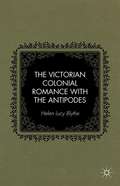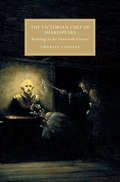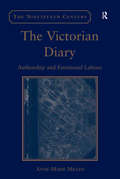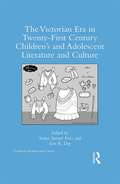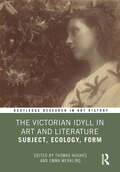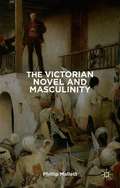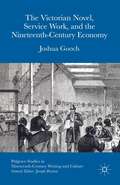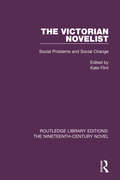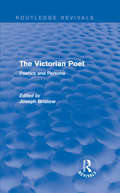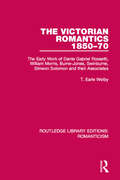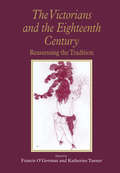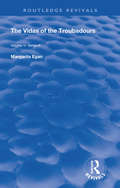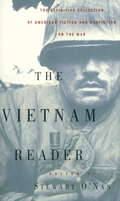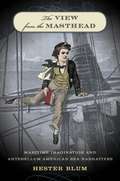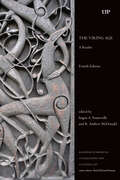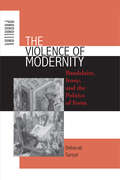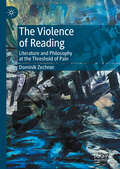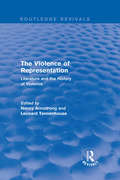- Table View
- List View
The Victorian Colonial Romance with the Antipodes
by Helen Lucy BlytheThe Victorian Colonial Romance with the Antipodes.
The Victorian Cult of Shakespeare: Bardology in the Nineteenth Century (Cambridge Studies in Nineteenth-Century Literature and Culture)
by Charles LaPorteIn the Victorian era, William Shakespeare's work was often celebrated as a sacred text: a sort of secular English Bible. Even today, Shakespeare remains a uniquely important literary figure. Yet Victorian criticism took on religious dimensions that now seem outlandish in retrospect. Ministers wrote sermons based upon Shakespearean texts and delivered them from pulpits in Christian churches. Some scholars crafted devotional volumes to compare his texts directly with the Bible's. Still others created Shakespearean societies in the faith that his inspiration was not like that of other playwrights. Charles LaPorte uses such examples from the Victorian cult of Shakespeare to illustrate the complex relationship between religion, literature and secularization. His work helps to illuminate a curious but crucial chapter in the history of modern literary studies in the West, as well as its connections with Biblical scholarship and textual criticism.
The Victorian Diary: Authorship and Emotional Labour (The Nineteenth Century Series)
by Anne-Marie MillimIn her examination of neglected diaristic texts, Anne-Marie Millim expands the field of Victorian diary criticism by complicating the conventional notion of diaries as mainly private sources of biographical information. She argues that for Elizabeth Rigby Eastlake, Henry Crabb Robinson, George Eliot, George Gissing, John Ruskin, Edith Simcox and Gerard Manley Hopkins, the exposure or publication of their diaries was a real possibility that they either coveted or feared. Millim locates the diary at the intersection of the public and private spheres to show that well-known writers and public figures of both sexes exploited the diary's self-reflexive, diurnal structure in order to enhance their creativity and establish themselves as authors. Their object was to manage, rather than to indulge or repress, their emotions for the purposes of perfecting their observational and critical skills. Reading these diaries as literary works in their own right, Millim analyses their crucial role in the construction of authorship. By relating these Victorian writers' diaries to their publications and to contemporary works of cultural criticism, Millim shows the multifarious ways in which diaristic practices, emotional management and professional output corresponded to experiences of the literary marketplace and to nineteenth-century codes of propriety.
The Victorian Era in Twenty-First Century Children’s and Adolescent Literature and Culture (Children's Literature And Culture Ser.)
by Sara K. Day Sonya Sawyer FritzVictorian literature for audiences of all ages provides a broad foundation upon which to explore complex and evolving ideas about young people. In turn, this collection argues, contemporary works for young people that draw on Victorian literature and culture ultimately reflect our own disruptions and upheavals, particularly as they relate to child and adolescent readers and our experiences of them. The essays therein suggest that we struggle now, as the Victorians did then, to assert a cohesive understanding of young readers, and that this lack of cohesion is a result of or a parallel to the disruptions taking place on a larger (even global) scale.
The Victorian Idyll in Art and Literature: Subject, Ecology, Form (Routledge Research in Art History)
by Thomas Hughes Emma MerklingResonating with contemporary ecological and queer theory, this book pioneers the theorization of the Victorian idyll, establishing its nature, lineaments, and significance as a formal mode widely practised in nineteenth-century British culture across media and genre. Chapters trace the Victorian idyll’s emergence in the 1830s, its flourishing in the 1860s, and its evolution up to the century’s close, drawing attention to the radicalism of idyllic experiments with pictorial, photographic, dramatic, literary, and poetic form in the work of canonical and lesser-known figures. Approaching the idyll through three intersecting categories—subject, ecology, and form—this book remaps Victorian culture, reshaping thinking about artistic form in the nineteenth century, and recalibrating accepted chronologies. In the representations by a host of Victorian artists and writers engaging with other-than-human forms, and in the natures of the subjectivities animated by these encounters, we find versions of Victorian ecology providing provocative imaginative material for ecocritics, scholars, writers, and artists today. This book will be of interest to scholars working in art history, English literature, Victorian studies, British history, queer and trans* theory, musicology, and ecocriticism, and will enliven debates pertaining to the environmental across periods.
The Victorian Novel and Masculinity
by Phillip MallettWhat did it mean, in the rapidly changing world of Victorian England, to 'be a man'? In essays written specially for this volume, nine distinguished scholars from Britain and the USA show how Victorian novelists from the Brontës to Conrad sought to discover what made men, what broke them, and what restored them.
The Victorian Novel and the Space of Art
by Dehn GilmoreThis interdisciplinary study argues for the vital importance of visual culture as a force shaping the Victorian novel's formal development and reading history. It shows how authors like Charles Dickens, William Makepeace Thackeray, Wilkie Collins and Thomas Hardy borrowed language and conceptual formations from art world spaces - the art market, the museum, the large-scale exhibition, and art critical discourse - not only when they chose certain subjects or refined certain aspects of realism, but also when they tried to adapt various genres of the novel for a new and newly vociferous mass audience. Quandaries specific to new forms of public display affected authors' sense of their relationship with their own public. Debates about how best to appreciate a new mass of visual information impacted authors' sense of how people read, and consequently the development of particular novel forms like the multi-plot novel, the historical novel, the sensation novel, and fin-de-sicle fiction.
The Victorian Novel, Service Work, and the Nineteenth-Century Economy (Palgrave Studies in Nineteenth-Century Writing and Culture)
by Joshua GoochThis book offers a much-needed study of the Victorian novel's role in representing and shaping the service sector's emergence. Arguing that prior accounts of the novel's relation to the rise of finance have missed the emergence of a wider service sector, it traces the effects of service work's many forms and class positions in the Victorian novel.
The Victorian Novel, Service Work, and the Nineteenth-Century Economy (Palgrave Studies in Nineteenth-Century Writing and Culture)
by Joshua GoochThis book offers a much-needed study of the Victorian novel's role in representing and shaping the service sector's emergence. Arguing that prior accounts of the novel's relation to the rise of finance have missed the emergence of a wider service sector, it traces the effects of service work's many forms and class positions in the Victorian novel.
The Victorian Novelist: Social Problems and Change (Routledge Library Editions: The Nineteenth-Century Novel #14)
by Kate FlintFirst published in 1987. Many Victorian novels that considered social problems made extensive use of contemporary source material for their descriptions. This book aims to provide a greater acquaintance with this non-literary material — illustrating and exemplifying issues that the authors treated imaginatively. The material is divided into parts dealing with: the industrial north of England, London and the agricultural poor. Extracts from writings that bear directly on the fiction of writers like Dickens and Gaskell are featured, as are Government Blue Books and newspaper reports and articles. This volume also contains articles by Dickens and others, from his magazine, Household Words.
The Victorian Period: The Intellectual and Cultural Context of English Literature, 1830 - 1890 (Longman Literature In English Series)
by Robin GilmourThis is a thought-provoking synthesis of the Victorian period, focusing on the themes of science, religion, politics and art. It examines the developments which radically changed the intellectual climate and illustrates how their manifestations permeated Victorian literature.The author begins by establishing the social and institutional framework in which intellectual and cultural life developed. Special attention is paid to the reform agenda of new groups which challenged traditional society, and this perspective informs Gilmour's discussion throughout the book. He assesses Victorian religion, science and politics in their own terms and in relation to the larger cultural politics of the middle-class challenge to traditionalism. Familiar topics, such as the Oxford Movement and Darwinism, are seen afresh, and those once neglected areas which are now increasingly important to modern scholars are brought into clear focus, such as Victorian agnosticism, the politics of gender, 'Englishness', and photography. The most innovative feature of this compelling study is the prominence given to the contemporary preoccupation with time. The Victorians' time-hauntedness emerges as the defining feature of their civilisation - the remote time of geology and evolution, the public time of history, the private time of autobiography.
The Victorian Poet: Poetics and Persona (Routledge Revivals)
by Joseph BristowThe practice of poetry in the Victorian period was characterised by an extreme diversity of styles, preoccupations and subject-matter. This anthology attempts to draw out some of the main focuses of interest in the Victorian poet. No Victorian poet produced an overall theory of poetry, yet all accepted it as a natural vehicle of expression, and for some subjects, in particular sexuality, the only literary mode. Indeed, the sexual question was made even more acute by the sudden phenomenon of the ‘poetess’, and the relation of poetry to gender raised interesting new critical questions. At the same time, the cultural role of the poet came under increasing debate: Victorian poetry was the first contemporary poetry to be studied. This selection of central texts illustrates these pressures on the Victorian practice of poetry, and the introductory remarks suggest ways in which theory can be related to the understanding key poems themselves.
The Victorian Romantics 1850-70: The Early Work of Dante Gabriel Rossetti, William Morris, Burne-Jones, Swinburne, Simeon Solomon and their Associates (Routledge Library Editions: Romanticism #26)
by T. Earle WelbyFirst published in 1929. This title explores the early work of five Victorian Romantics; Dante Gabriel Rossetti, William Morris, Edward Burne Jones, Algernon Charles Swinburne, and Simeon Solomon, and exhibits them at or soon after the moment of entry into the movement. This title will be of interest to students of literature and art history.
The Victorians and the Eighteenth Century: Reassessing the Tradition
by Francis O'Gorman Katherine TurnerDisrupting the common assumption that the Victorians regarded their eighteenth-century predecessors with little interest or with disdain, the essays in The Victorians and the Eighteenth Century propose a re-examination of these relationships. Together, they expose some of the significant and complex ways in which key aspects and texts of the eighteenth century were situated, read, and transacted within the post-Romantic nineteenth century. Individual essays examine the influence of the work of Pope and the eighteenth-century novelists such as Johnson, Chatterton, and Rousseau on a range of Victorian writers and cultural productions, including Dickens, Eliot, Oliphant, Ruskin, historical fiction, late Victorian art criticism, The English Men of Letters series, and the Oxford English Dictionary. The contributors challenge long-held views about Victorian uses of the past, and offer new insights into how the literature and culture of the eighteenth century helped shape the culture and identity of the nineteenth. This collection of essays by an impressive array of scholars, with a Preface by David Fairer, represents a unique approach to this area of literary history and offers new perspectives on the nature and methodology of 'periodization'. While it is obviously of great interest to students of eighteenth-century and Victorian literature, it will also appeal to readers more broadly concerned with questions of literary influence, periodization, and historiography.
The Victory Garden Vegetable Alphabet Book
by Jerry Pallotta Bob ThomsonFrom asparagus to zucchetta, the author zips through the ABC's while introducing children to edible plants, animals and gardening concepts. "Y y Y is for Yard Long Bean. This bean can grow to be about 36 inches long. You can use it for a belt, you can pretend it is a jumprope, or you can cook it and have a very long lunch." A marvelous alphabet book. This file should make an excellent embossed braille copy.
The Vidas of The Troubadours (Routledge Revivals)
by Margarita EganPublished in 1984: These texts which have been little studied for their literary qualities represent a vital link between the didactic tradition of the Middle Ages and the fictional short stories of the Renaissance, such as the thirteenth-century collection of tales known as the Novellino, and later, Boccaccio's Decameron.
The Vietnam Reader: The Definitive Collection of American Fiction and Nonfiction on the War
by Stewart O'NanThe Vietnam Reader is a selection of the finest and best-known art from the American war in Vietnam, including fiction, nonfiction, poetry, drama, film, still photos, and popular song lyrics. All the strongest work is here, from mainstream bestsellers to radical poetry, from Tim O'Brien to Marvin Gaye. Also included are incisive reader's questions--useful for educators and book clubs--in a volume that makes an essential contribution to a wider understanding of the Vietnam War.This authoritative and accessible volume is sure to become a classic reference, as well as indispensable and provocative reading for anyone who wants to know more about the war that changed the face of late-twentieth-century America.From the Trade Paperback edition.
The View From Serendip
by Arthur C. ClarkeThis book includes many articles on the personal universe of Arthur C. Clarke, including life at home on his island paradise, in ancient times called Serendip, then Ceylon, now Sri Lanka, his continuing involmement with space travel from the earliest days as a member of the British interplanetary Society to his coverage of the Apollo moon shots for CBS television, to the world of 2001 ... or what's in store for us in the nest 20 years, and more
The View from Somewhere: Undoing the Myth of Journalistic Objectivity
by Lewis Raven Wallace#MeToo. #BlackLivesMatter. #NeverAgain. #WontBeErased. Though both the right- and left-wing media claim “objectivity” in their reporting of these and other contentious issues, the American public has become increasingly cynical about truth, fact, and reality. In The View from Somewhere, Lewis Raven Wallace dives deep into the history of “objectivity” in journalism and how its been used to gatekeep and silence marginalized writers as far back as Ida B. Wells. At its core, this is a book about fierce journalists who have pursued truth and transparency and sometimes been punished for it—not just by tyrannical governments but by journalistic institutions themselves. He highlights the stories of journalists who question “objectivity” with sensitivity and passion: Desmond Cole of the Toronto Star; New York Times reporter Linda Greenhouse; Pulitzer Prize-winner Rachel Kaadzi Ghansah; Peabody-winning podcaster John Biewen; Guardian correspondent Gary Younge; former Buzzfeed reporter Meredith Talusan; and many others. Wallace also shares his own experiences as a midwestern transgender journalist and activist who was fired from his job as a national reporter for public radio for speaking out against “objectivity” in coverage of Trump and white supremacy. With insightful steps through history, Wallace stresses that journalists have never been mere passive observers—the choices they make reflect worldviews tinted by race, class, gender, and geography. He upholds the centrality of facts and the necessary discipline of verification but argues against the long-held standard of “objective” media coverage that asks journalists to claim they are without bias. Using historical and contemporary examples—from lynching in the nineteenth century to transgender issues in the twenty-first—Wallace offers a definitive critique of “objectivity” as a catchall for accurate journalism. He calls for the dismissal of this damaging mythology in order to confront the realities of institutional power, racism, and other forms of oppression and exploitation in the news industry. Now more than ever, journalism that resists extractive, exploitive, and tokenistic practices toward marginalized people isn’t just important—it is essential. Combining Wallace’s intellectual and emotional journey with the wisdom of others’ experiences, The View from Somewhere is a compelling rallying cry against journalist neutrality and for the validity of news told from distinctly subjective voices.
The View from the Masthead
by Hester BlumWith long, solitary periods at sea, far from literary and cultural centers, sailors comprise a remarkable population of readers and writers. Although their contributions have been little recognized in literary history, seamen were important figures in the nineteenth-century American literary sphere. In the first book to explore their unique contribution to literary culture, Hester Blum examines the first-person narratives of working sailors, from little-known sea tales to more famous works by Herman Melville, James Fenimore Cooper, Edgar Allan Poe, and Richard Henry Dana.In their narratives, sailors wrote about how their working lives coexisted with--indeed, mutually drove--their imaginative lives. Even at leisure, they were always on the job site. Blum analyzes seamen's libraries, Barbary captivity narratives, naval memoirs, writings about the Galapagos Islands, Melville's sea vision, and the crisis of death and burial at sea. She argues that the extent of sailors' literacy and the range of their reading were unusual for a laboring class, belying the popular image of Jack Tar as merely a swaggering, profane, or marginal figure. As Blum demonstrates, seamen's narratives propose a method for aligning labor and contemplation that has broader applications for the study of American literature and history.
The Viking Age: A Reader, Fourth Edition (Readings in Medieval Civilizations and Cultures #XIV)
by Angus A. Somerville R. Andrew McDonaldThe fourth edition of The Viking Age provides an extensive deep dive into the world of the Vikings, spanning from the eighth and ninth centuries to the present, while also featuring key scholarly interpretations from the late twentieth and early twenty-first centuries. Building on the structure and content of previous editions, nearly every chapter has been reworked and expanded, with the addition of an entirely new chapter on commerce and trade. This edition broadens the range of materials while preserving the innovations of earlier editions and advancing them in new directions. In The Viking Age, readers are submerged in a comprehensive exploration of the Viking era, covering essential topics such as the role of women in Viking society, the significance of slavery in the Viking economy, commerce and trade, the use of Arabic sources, Viking religion, fertility gods, guardian spirits, the exploits of the Norse kings of Man and the Isles, the importance of Scandinavian and maritime law, the enduring legacy of the Vikings, and more. This extensively revised edition ultimately brings the Vikings and their world to life for twenty-first-century students and instructors.
The Viking Age: A Reader, Third Edition (Readings in Medieval Civilizations and Cultures)
In this extensively revised third edition of The Viking Age: A Reader, Somerville and McDonald successfully bring the Vikings and their world to life for twenty-first-century students and instructors. The diversity of the Viking era is revealed through the remarkable range and variety of sources presented as well as the geographical and chronological coverage of the readings. The third edition has been reorganized into fifteen chapters. Many new sources have been added, including material on gender and warrior women, and a completely new final chapter traces the continuing cultural influence of the Vikings to the present day. into the twenty-first century. The use of visual material has been expanded significantly, and updated maps illustrate historical developments throughout the Viking Age. The NorseEnglish translations of Norse texts, many of them new to this collection, are straightforward and easily accessible, while chapter introductions contextualize the readings.
The Violence of Modernity: Baudelaire, Irony, and the Politics of Form (Parallax: Re-visions of Culture and Society)
by Debarati SanyalThe Violence of Modernity turns to Charles Baudelaire, one of the most canonical figures of literary modernism, in order to reclaim an aesthetic legacy for ethical inquiry and historical critique. Works of modern literature are commonly theorized as symptomatic responses to the trauma of history. In a climate that tends to privilege crisis over critique, Debarati Sanyal argues that it is urgent to rethink literary experience in terms that recall its contestatory potential. Examining Baudelaire's poems afresh, she shifts the focus of critical attention toward an account of modernism as an active engagement with violence, specifically the violence of history in nineteenth-century France.Sanyal analyzes a literary current that uses the traditional hallmarks of modernism—irony, intertextuality, self-reflexivity, and formalism—to challenge the historical violence of modernity. Baudelaire and the committed ironists writing in his wake teach us how to read and resist the violence of history, and thereby to challenge the melancholy tenor of our contemporary "wound culture." In a series of provocative readings, Sanyal presents Baudelaire's poetry as an aesthetic form that contests historical violence through rhetorical strategies of complicity, counterviolence, and critique. The book develops a new account of Baudelaire's significance as a modernist by dislodging him both from his traditional status as a practitioner of "art for art's sake" and from his more recent incarnation as the poet of trauma. Following her extended analysis of Baudelaire's poetry, Sanyal in later chapters considers a number of authors influenced by his strategies—including Rachilde, Virginie Despentes, Albert Camus, and Jean-Paul Sartre—to examine the relevance of their interventions for our current climate of trauma and terror. The result is a study that underscores how Baudelaire's legacy continues to energize literary engagements with the violence of modernity.
The Violence of Reading: Literature and Philosophy at the Threshold of Pain
by Dominik ZechnerThe Violence of Reading: Literature and Philosophy at the Threshold of Pain expounds the scene of reading as one that produces an overwhelmed body exposed to uncontainable forms of violence. The book argues that the act of reading induces a representational instability that causes the referential function of language to collapse. This breakdown releases a type of “linguistic pain” (Scarry; Butler; Hamacher) that indicates a constitutive wounding of the reading body. The wound of language marks a rupture between linguistic reality and the phenomenal world. Exploring this rupture in various ways, the book brings together texts and genres from diverse traditions and offers close examinations of the rhetoric of masochism (Sacher-Masoch; Deleuze), the relation between reading and abuse (Nietzsche; Proust; Jelinek), the sublime experience of reading (Kant; Kafka; de Man), the “novel of the institution” (Musil; Campe), and literary suicide (Bachmann; Berryman; Okkervil River).
The Violence of Representation: Literature and the History of Violence (Routledge Revivals)
by Nancy Armstrong Leonard TennenhouseFirst published in 1989, this collection of essays brings into focus the history of a specific form of violence – that of representation. The contributors identify representations of self and other that empower a particular class, gender, nation, or race, constructing a history of the west as the history of changing modes of subjugation. The essays bring together a wide range of literary and historical work to show how writing became an increasingly important mode of domination during the modern period as ruling ideas became a form of violence in their own right. This reissue will be of particular value to literature students with an interest in the concept of violence, and the boundaries and capacity of discourse.
